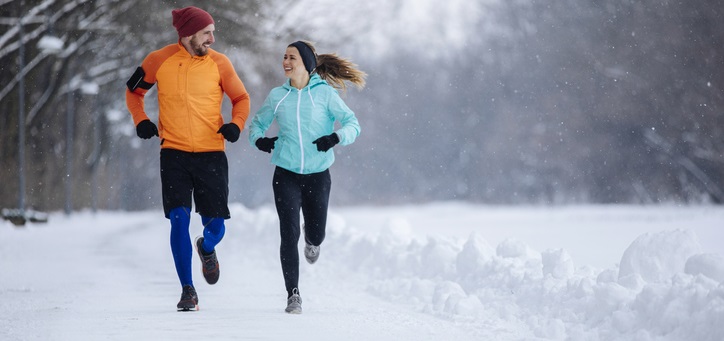7 tips to stay safe when exercising in the cold

It can be tough to follow through on your New Year's resolution to exercise more when the weather is still chilly. But you don’t have to let frigid temperatures stop you from getting into shape.
Exercise should be an important part of your routine because it helps you maintain or improve your overall health and well-being. It comes with many immediate and long-term benefits, including better mood, lower blood pressure, and lower risk for heart disease and Type 2 diabetes.
Stay safe and get fit by following these tips for exercising in cold weather:
- Check weather conditions and wind chill. Before you head outside, review the temperature, wind and moisture. Even if you’re wearing warm clothing, extreme wind chill can make exercising outdoors unsafe. Unless you have waterproof gear, don’t work out if it’s raining or snowing because getting wet in the cold could lower your core body temperature.
- Watch for frostbite and hypothermia. Frostbite results in numbness or a stinging sensation on exposed skin, such as your cheeks, nose and ears. If you think you have frostbite, get out of the cold, and slowly warm the affected area by running it under lukewarm water or wrapping it in a blanket. Hypothermia occurs when the body loses more heat than it can make. Symptoms include intense shivering, slurred speech, loss of coordination and fatigue. Seek emergency help immediately if you suspect hypothermia.
- Dress in layers. You might think you need to bundle up when exercising outside, but exercising generates a lot of heat. Instead, dress in layers that you can remove if you start sweating too much and put back on if you get chilly. Put on a synthetic material, not cotton, for your first layer, then add on a layer of fleece or wool for insulation. Finally, put on a waterproof layer, such as a rain coat.
- Don’t forget to protect hands, feet, head and ears. Wear a thin pair of gloves underneath a pair of heavier gloves or mittens, which you can remove if your hands get sweaty. Wear shoes slightly larger than your normal size so that you can wear thicker socks or an extra pair of regular socks. Make sure that your shoes have enough traction to prevent falls if it’s snowy or icy, too. Protect your head and ears by wearing a beanie or headband, and bring a scarf to protect your face as well if it’s extra chilly.
- Be visible. Because there’s less daylight during the winter, wear reflective clothing if you exercise when it’s dark so that drivers can see you.
- Drink lots of water. Even if you’re not thirsty, drink plenty of water before, during and after your workout because hydration is always important.
- Have a backup plan. It’s OK to skip a workout if it’s too cold. Alternatively, you can stay home and work on strengthening and flexibility exercises, or you can hit the gym. If you do decide to work out in the cold, be sure to let someone know where you’re going and when you expect to be back in case something goes wrong.
This content was produced by UK HealthCare Brand Strategy.




